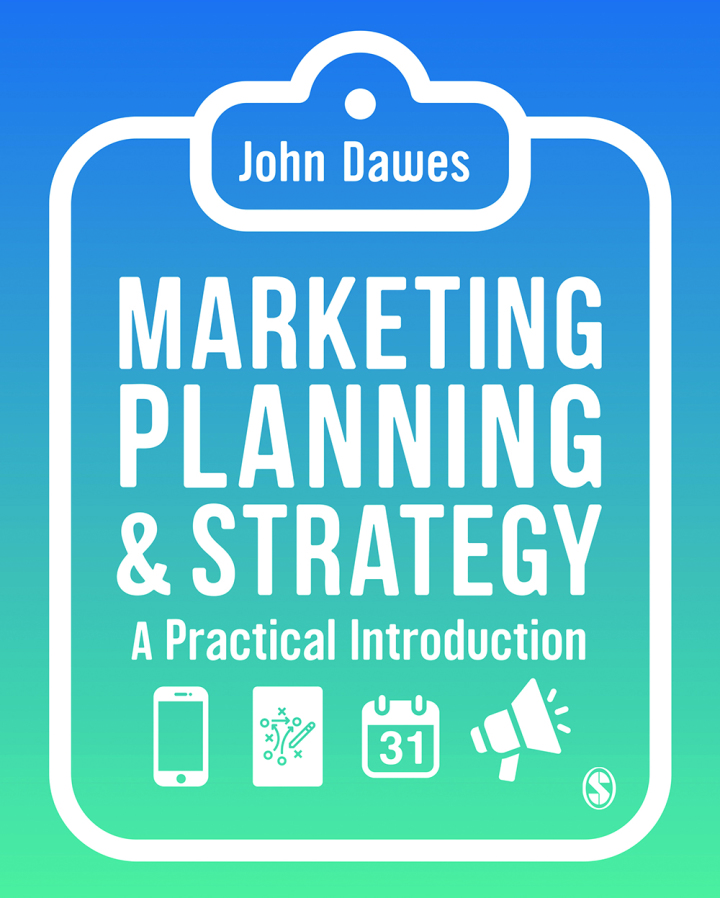
Marketing Planning & Strategy 1st Edition - A Practical Introduction
PUBLISHER: Sage
Trường ĐH, Nhóm, Thư Viện: Gọi 0915920514 để báo giá eBook hosting trên Vital Source hoặc mua Sách In
Kế hoạch & Chiến lược tiếp thịGiới thiệu thực tếChúng tôi biết bạn háo hức học các kỹ năng thực tế tại nơi làm việc ở trường đại học để "sẵn sàng làm việc" sau khi tốt nghiệp. Trong tiếp thị, một trong những điều thiết thực nhất mà bạn có thể học cách làm là tạo ra một kế hoạch tiếp thị hợp lý. Cuốn sách mới này hướng dẫn bạn một cách ngắn gọn về quy trình lập kế hoạch tiếp thị từ đầu đến cuối, dựa trên các ví dụ từ các thương hiệu lớn như Ikea và Krispy Kreme cho đến các công ty khởi nghiệp kỹ thuật số như Starling Bank. Có một nghiên cứu điển hình đang diễn ra về một doanh nghiệp dịch vụ nhỏ chia nhỏ kế hoạch tiếp thị thành các phần dễ hiểu. Một chương dành riêng về các khái niệm chiến lược tiếp thị để giúp bạn hiểu cách chúng liên kết với các yếu tố thị trường, công ty hoặc liên quan đến quyết định. Các câu hỏi và tình huống tự kiểm tra với các nhiệm vụ xuyên suốt mang lại trải nghiệm học tập tích cực. Thực tế trong cách tiếp cận từng bước cũng như bao gồm các hoạt động và kịch bản và được viết đơn giản trong khi vẫn được củng cố bởi học thuật về chiến lược tiếp thị, cuốn sách này sẽ giúp bạn phát triển khả năng ra quyết định tiếp thị xuyên suốt bằng cách học các kỹ năng chính như cách thực hiện SWOT phân tích và làm thế nào để lập ngân sách và dự báo một cách chính xác. Được hỗ trợ bởi các tài nguyên trực tuyến dành cho giảng viên bao gồm các slide PowerPoint, sách hướng dẫn dành cho người hướng dẫn và giáo trình gợi ý. Đọc thích hợp cho các khóa học lập kế hoạch tiếp thị và chiến lược tiếp thị.
About the AuthorAcknowledgementsPraise for the BookPreface: Why Another Book on Marketing Planning and Strategy?Online ResourcesPART I CONSTRUCTING THE PLAN1 Planning Introduction: Is it Good to Do Formal Planning?What is involved in marketing planning?Arguments for formal planning – either a marketing plan or a business planHow sound planning can pay off – the case of Starling BankA reality check before we go further – competitive advantage?Wording in a marketing plan – dos and don’ts, with examples2 The Front-end of a Plan: The Executive Summary3 The Internal AnalysisWhat is this analysis for?Resources and capabilities auditPrevious performanceProduct auditChannel auditPricing auditAdvertising auditBusiness relationships auditKey issuesIntroduction to the marketing plan case study: Remedy Physiotherapy ClinicMarketing plan case study: internal analysisMarketing plan case study: internal analysis work tasksMarketing plan case study: internal analysis template4 The Global Environment AnalysisDemographicEconomicSocial/culturalTechnologicalEnvironmental/natural resourcesPolitical/legalPulling the global environment analysis togetherGlobal environment analysisMarketing plan case study: global environment analysis template5 The Market Environment AnalysisMarket auditCustomer auditCompetitor auditMarketing plan case study: market environment analysisMarketing plan case study: market environment audit work tasksMarketing plan case study: market environment analysis template6 Bringing the Analyses Together: SWOTThe basic SWOTA more elaborate version of SWOTMarketing Plan Case Study: SWOT7 Objectives and AssumptionsObjectivesAssumptionsMarketing plan case study: objectives and assumptions work tasksMarketing plan case study: objectives and assumptions template8 Marketing StrategyA note on weaknessesExample marketing strategy: Askren HomesComponents of the marketing strategyUnderstanding strategy conceptsStrategy concept checklistMarketing plan case study: marketing strategy template9 Marketing ProgrammeCommunications decisionsProduct decisionsPricing decisionsDistribution decisionsMapping marketing activity in a timelineMarketing plan case study: marketing programme template10 Marketing BudgetPercentage of sales methodTask methodCompetitive method‘How much money do we have available’ methodWhich method to use?What is ‘zero-based budgeting’?Marketing as a cost, or can it pay for itself?What is a sensitivity analysis?Marketing plan case study: budget template11 Key Metrics and Market ResearchEnd-result metricsMarket-based asset metricsPrecursors to sales metricsActivity metricsA sidenote: marketing return on investmentMarket researchBibliography/information sourcesMarketing plan case study: metrics, market research template12 How to Construct Good Tables and Graphs for Your Marketing PlanGood practice for presenting data in tablesWhat sort of graphs to use13 Marketing Planning Scenarios, with TasksMini Case 1 – Marketing for a small, not-for-profit enterpriseMini Case 2 – Marketing for a hire companyMini Case 3 – Gary’s garage doorsPART II READINGS AND KNOWLEDGE BASE14 Marketing Planning and EthicsWhy has ethical behaviour become a more prominent concept in marketing?The components of marketing ethicsMarketing ethics checklist: does our marketing strategy incorporate these points?Ethically challenging situations: what is the issue and what would you do?15 Prominent Strategy Models in MarketingGeneric strategies: time to stop!Growth-share matrices – useful or unhelpful?The Ansoff matrix: a legendary tool, but with two logical problemsThe resource-based theory of competitive advantage16 Empirical Generalisations and Their Link to Marketing PlanningDouble jeopardyBuyers buy from repertoires of brandsThe duplication of purchase lawBuying frequencies generally follow an NBD patternUser profiles of competing brands are usually quite similarThe natural monopoly effectCompetitor-oriented objectives are detrimentalCustomer satisfaction is important, but it is not what distinguishes big from small brandsAdvertising does work, even without short-term sales liftsShare of voice is related to market sharePrice elasticity averages around -2.5, and varies according to known contextsMarketing communication has diminished effects from multiple exposures in a period17 Management Beliefs and Biases, and What They Mean for Marketing Planning and StrategyCorrelation and causation – the misleading of managementThe halo effectThe narrative fallacySelection biasStatus quo biasRegression to the meanThe planning fallacyAssuming ‘what’s important’ to buyers is the panaceaReferencesIndex















